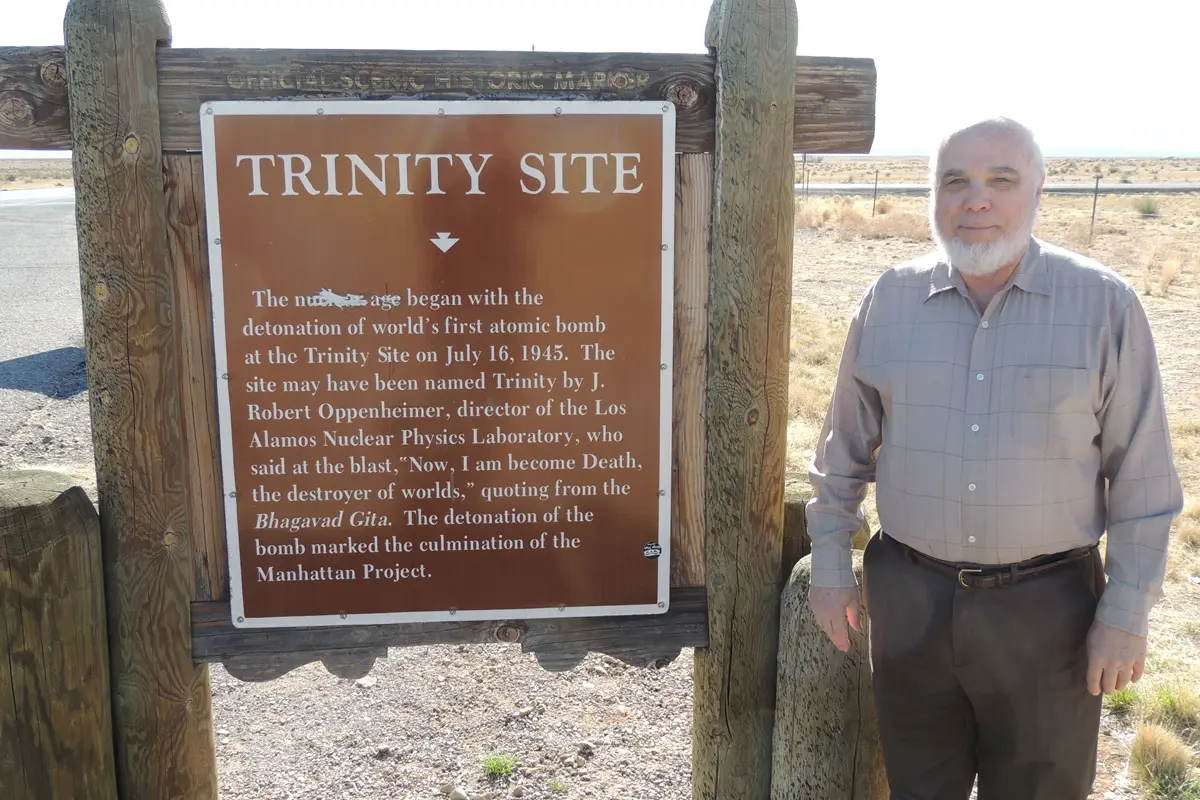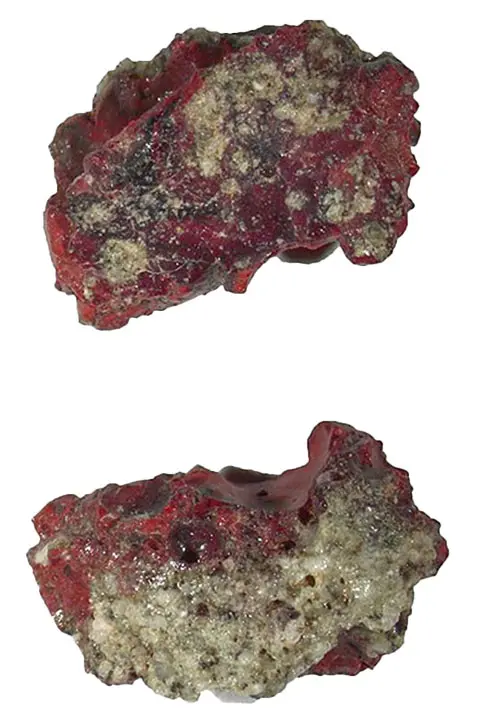Geoscientists Study Clues to Understand How the Earth Evolved

04/16/2024
By Katharine Webster
The mysteries of Earth’s evolution are locked inside rocks, from volcanic magma to frozen sediments and grains of sand. And UMass Lowell geoscientists hold some of the keys.
Assoc. Profs. Kate Swanger and Richard Gaschnig and Prof. Nelson Eby go river deep and mountain high in their quest to understand Earth’s climate and history as long ago as millions and billions of years.
Their research even yields insights into other planets and their potential to support life, as well as space phenomena like quasicrystals—crystals that do not follow the ordinary rules of symmetry.
Just as important, their work offers unique opportunities for hands-on research to students in the Department of Environmental, Earth and Atmospheric Sciences. From undergraduates pursuing the geoscience option within environmental science to Ph.D. students in the new Earth System Science program, UMass Lowell students have done research in places as far-flung as Antarctica and as close to campus as the White Mountains of New Hampshire.
“It’s science for the pure sake of learning,” says Swanger, who analyzes changes to Antarctica caused by fluctuations in Earth’s climate. “A lot of advances in technology occur because of this kind of pure, basic science.”
Here are some of the fundamental questions that their research is addressing.
Rock Glaciers and Meltwater in Antarctica
Swanger is a geomorphologist and paleoclimatologist who seeks to understand how natural ice ages and warmer periods over the past 5 million years affected Antarctica’s landscape, as a baseline for understanding how recent climate change is altering and will continue to alter that continent.
“I map glacial deposits—when was the ice sheet bigger, when were glacial periods longer—trying to tie that to the climate signal,” says Swanger, a member of the university’s Climate Change Initiative.

She’s especially interested in rock glaciers, which include glacial flows that have a pure ice core covered by a layer of sand, gravel and rock debris and “talus glaciers” that consist of rock fragments and sediment bound together by ice. She also examines the permafrost layer, soil that remains frozen for years on end, as well as sediments left behind by melting glacial ice.
The permafrost and rock glaciers in the McMurdo Dry Valleys potentially encapsulate millions of years of climate history, “so studying these landforms could provide a better understanding of glacier fluctuations and long-term climate trends,” Swanger says.
In the past few years, Swanger has been examining meltwater streams. In one study, she found that streams that have formed in the last 12,000 years, since the end of the last ice age, increase the melt rate of ice-core rock glaciers that formed 100,000 years ago. That melt rate has accelerated during recent hot summers, she says. In contrast, the streams can both melt talus glaciers and rebuild them by depositing new sediment and ice, she found.
“It’s science for the pure sake of learning. A lot of advances in technology occur because of this kind of pure, basic science.” -Kate Swanger
“In the Dry Valleys, there is evidence of increased melting of glaciers and permafrost during the past two decades, a response to modern climate change that is potentially different from other warm intervals further in the past,” she says.
Under her latest National Science Foundation grant, Swanger and second-year Ph.D. student Mika Bighin are mapping and dating active and dry streams that have fed lakes in the McMurdo Dry Valleys over the past 100,000 years. They will visit Antarctica next summer to collect samples; meanwhile, they are learning, with help from Gaschnig and Ph.D. student Ericka Boudreau ’20, ’22, how to analyze zircon in stream and lake-bed sediments.
“We find the ratio of uranium and lead isotopes in the zircon to see how old it is,” explains Bighin. “Then we can try to match it up with different locations it might have come from, like rocks in the valley walls or rocks transported by ice sheets.”
Continental Rifts and Plate Tectonics
Gaschnig is a geochemist who focuses on the deep history of Earth’s crust, especially the formation of the continents and supercontinents through the movement of tectonic plates. He is particularly interested in how the western United States was formed.
Under grants from the National Science Foundation, he and his students collect samples at the continents’ edges, failed and future continental rifts, and features resulting from plate tectonics, including volcanoes and mountain ranges. His work has taken him to China, South Africa, Namibia and Canada. Stateside, he has led undergraduates on field research to Idaho, Montana and Oregon.

Using a combination of laser ablation and mass spectrometry, they analyze sands and rocks for microscopic mineral signatures that suggest, for example, that California was once connected to Australia and Massachusetts adjoined Morocco.
“If you find sediments in North America, like sandstone, each one of those sand grains has potentially a unique history,” Gaschnig says. “A certain fraction are special minerals that originally formed from magma, which we can date. Then we can look for rocks on another continent that might match.”
Boudreau, who has been doing research with Gaschnig since she was an undergraduate, used those techniques to show that a little section of what is now southwestern Oregon was once part of Baja California. It’s one of the best examples of geochemistry confirming earlier paleomagnetic research that indicates the Pacific and North American tectonic plates have moved vast distances over hundreds of millions of years.
Although relatively recent volcanic activity along the West Coast had overwritten much of the chemical record, Boudreau and Gaschnig overcame that handicap by analyzing zircon and other key minerals in sand from the Oregon coast. Zircon originally forms in magma under extremely hot temperatures and is preserved when that magma cools and crystallizes into granite.
“I’m just curious about everything.” -Nelson Eby
When granite erodes, it releases the zircon into rivers as tiny sand grains that can travel thousands of miles. The isotopes within the zircon provide a unique signature and time stamp for when the zircon and its source rock solidified, and other chemical elements can help to confirm the rock’s age and origins, Boudreau says.
“Monazite can form under really low-temperature conditions, when sand is becoming a sandstone, and with rutile (the most common form of titanium dioxide found in nature), you can figure out the specific temperatures that it forms at,” she says. “Each of these different minerals tells a part of the story of this one rock.”
Gaschnig’s research into the geological history of the crust, which evolved starting 3 billion years ago from the dense rock still found on the ocean floor into less dense rocks that make up most of the continents, also could help scientists determine whether other exoplanets have the potential to support life. “Without plate tectonics, you probably can’t have continents and a stable climate that would support life,” he says.
Breakthroughs Could Help Nuclear Forensics
Eby is an all-purpose geochemist and “geo-detective” who enjoys historical projects, such as analyzing the radioactive, glassy materials that formed during the Trinity atomic bomb test.
He also does research on alkaline rock, which contains high ratios of rare earth metals, which are increasingly used in green technologies. Rare earth metals are scarce and difficult to find in the natural environment, but Eby’s research is helping to crack the code of the ingredients and conditions that form them.

His students benefit from that curiosity. On a wintry Friday afternoon, three undergraduate research assistants— seniors Lily Evans, Dennis van Maaren and Francis O’Brien, who are all on track to earn master’s degrees in environmental geoscience through the Bachelor’s-to-Master’s Program—accompanied Eby as he sent a sample of slag from ancient Japanese copper smelters through the university’s research reactor. Then they trooped back up to his lab and watched while he measured the half-life of various isotopes to determine the slag’s mineral composition.
“I find minerology really interesting, and this is a good opportunity to learn about research,” says van Maaren, who wants to join a research lab and apply to Ph.D. programs after completing his master’s.

Eby has made a career of finding answers to such questions, employing various geochemical techniques. Recently, he helped to analyze a rock formed by the Trinity nuclear test after the fireball vaporized desert sand, the iron test tower and copper transmission lines connected to scientific recording instruments. The blast vapor cooled and rained down as a radioactive glass, which was then dubbed “trinitite.”
A 20-faced crystal found in a copper-rich sample of red trinitite is the first known instance of a man-made quasicrystal, but it resembles some quasicrystals found in meteorites, says Eby, who figured out the approximate temperature that led to the novel crystal’s formation, based on his previous research into atomic glasses.
Quasicrystals have potential industrial applications, but Eby is just as interested in how trinitite can reveal the origins of the radioactive material in the explosion that created it, thus helping in future nuclear forensic investigations. “Should a bad actor detonate an atomic device, the products of the blast can be used to determine the bomb maker,” he says.
